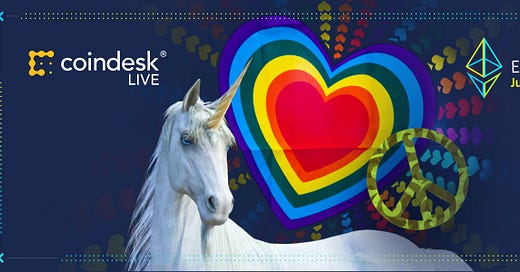Ethereum at Five: BUIDLers and Bufficorns
A romp through the first half-decade of the original general-purpose blockchain

“To have and to hold, from this day forward, for better, for worse, for richer, for poorer, in sickness and in health, until death do us part.” Beautiful words at a wedding. But a recipe for needless misery in financial contracts.
So argued economist Robert J. Schiller in his book “Finance and the Good Society,” published in 2013, as the U.S. housing market was still recovering from the 2008 crash. Part of the problem, according to Schiller, was the inadaptability of mortgage contracts written during good times.
“Debt should be flexible, should respond to economic circumstances,” he wrote, proposing that home loans come with “preplanned workouts” that would “specify changes in the terms of the mortgage in the event of an economic contraction or a fall in home prices.” Think of it as a prenup for the mortgage.
Neither bankers nor policymakers were interested in Schiller’s proposal, for which he blamed their “rigidity of thought.” Seven years later, as COVID-19 had plunged the economy into what looks to be a depression, his concept remains just that.
I’m not going to say “Ethereum fixes this.” But … maybe?
Smart contracts, which the world’s first general-purpose blockchain made possible at greater scale and complexity than before, could theoretically be programmed to adjust the terms of a mortgage when circumstances change. Oracle services could provide the off-chain data that would trigger those adjustments – they would notify the smart contract if, for example, the unemployment rate in the homeowner's city increased by a certain threshold, if real estate prices tanked, or if even more granular events occurred, like a member of the household losing a job.
Instead of subjecting consumers to the Kafkaesque labyrinth of faceless, unaccountable call-center employees and government loan-modification bureaucrats (remember HARP and HAMP?), everything adjusts automatically. Fewer foreclosures, fewer boarded-up houses blighting the streets, fewer defaults blighting credit records, fewer cases clogging the courts.
I can anticipate all sorts of valid objections to this idea, not least of all that we don’t yet know if Ethereum, or any blockchain, will ever scale to handle anything close to a multi-trillion dollar industry like the U.S. mortgage market. Stablecoins have shown that you can represent dollars on-chain, but are arguably too untested and risky for mass adoption. And one might question whether enshrining a mortgage in code introduces its own needless inflexibility. What if the programmer underestimated the amount of relief needed, and the borrower still can’t afford the payment?
The point is not that we should start writing everyone’s mortgages on Ethereum, or one of its rivals, today. (Just to be clear: We should not.) Rather, it’s that in the five years since its inception, the platform has opened up new possibilities for creative finance. Unfortunately, much of that creativity has been channeled to high-risk endeavors like flash loans (just that name gives me subprime flashbacks). But it needn’t be confined to rascally arbitrage.
And as even Schiller (a crypto skeptic) would likely agree, the world needn’t be wedded to the limitations of legacy finance.
Marc Hochstein, Executive Editor, CoinDesk

Today on CoinDesk Live
Year Zero: From Those Who Were There – Thursday, July 30, 4 p.m. ET
Speakers: Anthony Di Iorio, Anthony D’Onofrio, Adam Levine, Camila Russo, Ken Seiff
Getting the “world computer” operational was no easy task. Hear about the 24/7 coding, the infighting and the instant millions minted in that process. Camila Russo, author of the new book “The Infinite Machine,” digs into Ethereum’s highs and lows with the programmers, entrepreneurs and investors who got in on the ground floor.
Join our Discord community to chat during CoinDesk Live.

CoinDesk Live Recap: The DAO Hack Is Still a Mystery
By Doreen Wang and Zack Seward
The DAO exploit of 2016 was a $55 million heist that forever altered Ethereum’s trajectory.
On Tuesday, CoinDesk Live gathered a handful of blockchain veterans to look back at the incident. Cornell computer science professor Emin Gün Sirer, white-hat hacker Griff Green and MyEtherWallet founder Taylor Monahan were joined by Bloomberg reporter Matt Leising to unpack the hack’s lingering mysteries.
Beyond leading to a contentious hard fork and the creation of Ethereum Classic, The DAO hack laid bare core issues relating to blockchain development.
As Gün Sirer put it on Tuesday: “Is code law or do these systems serve human purposes?”

Ethereal Bestiary

By Doreen Wang
The collaborative spirit of ETHDenver is symbolized by its fantastical mascot, the bufficorn. Allegedly living atop Colorado’s tallest mountain peaks, bufficorns strive to serve their communities above their own interests. Their rallying cry: “BUIDL!”
The term is Ethereum’s response to bitcoin’s HODL, a call to build and contribute to the blockchain ecosystem, rather than passively holding digital coins. This can involve buying and selling cryptocurrencies, utilizing smart contracts, playing blockchain games or other activities to help evolve and expand the field.
“Magic of the unicorn, strength of a buffalo,” goes the Ballad of the Bufficorn at ETHDenver. The animals live to create a better world for all creatures great and small. They are mascots for ETHDenver, the world’s largest #BUIDLathon, held annually to foster collaboration and contribution to the global blockchain ecosystem.

CoinDesk Live Recap: DeFi Luminaries Discuss What’s Next
By Nathan DiCamillo
For decentralized finance (DeFi) to make its mark, it must reach beyond the crypto bubble, said MakerDAO founder Rune Christensen.
“Compared to where we’re going next, we’ve still just scratched the surface of what this technology will do,” Christensen, whose lending platform recently topped $1 billion in committed assets, said.
He was joined by fellow DeFi superstars Robert Leshner and Hayden Adams on Wednesday in a live-streamed conversation on the state of the $3.8 billion DeFi market. The session, part of CoinDesk’s Ethereum at Five series, was moderated by reporter Will Foxley.
It will certainly be a hard row to hoe, but the craze for yield farming and other middleman-less innovations could yet subvert traditional lenders. To date, DeFi has arguably been Ethereum’s best use case.

Blast From the Past
By Christie Harkin
That time when Vitalik Buterin (in white shirt) met with Vladimir Putin (solid red tie) and everyone went wild:


Ethereum History in 5 Charts

Part 4: Dapp Dominance
By Christine Kim and Shuai Hao
Ethereum’s vision since its inception has always been to be “the world computer” on top of which decentralized applications (dapps) and assets of any kind can be freely created and deployed.
To this end, Ethereum developers pioneered new technology in the emerging space of blockchain called “smart contracts.” A new programming language called Solidity was invented to help code dapps on Ethereum. In order to ensure interoperability between different dapps on the network, common frameworks were developed – like the ERC-20 and ERC-721 token standards.
These innovations have blazed the trail for other general-purpose blockchain platforms to emerge since Ethereum’s birth in 2015. EOS, Stellar, Tezos and Tron are four cryptocurrencies in the top 15 by market share that also feature dapp creation and deployment. Despite the growth in the number of alternative dapp platforms, Ethereum remains the most popular general-purpose blockchain both in terms of number of users and dapps, as shown in the chart above.
Ethereum hasn’t fulfilled its vision yet, however. Developers are convinced that the current blockchain infrastructure is wholly inadequate to handle an influx of millions, if not billions of users around the world. This was always the suspicion of the early founders of Ethereum, including Vitalik Buterin. Five years after releasing their creation into the wild, Buterin and others have worked out a roadmap called “Eth 2.0” to bring Ethereum’s development to completion. Eth 2.0’s first step is expected to launch sometime this year or early next.
Next in Ethereum History: The Road to 2.0…


Did you enjoy this email?
This newsletter was brought to you by CoinDesk editors Christie Harkin, Marc Hochstein, Elaine Ramirez and Zack Seward.
Get in touch at social@coindesk.com or reply to this email. Spread the word:


